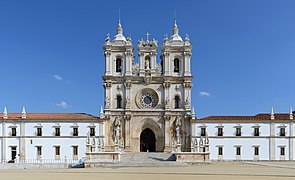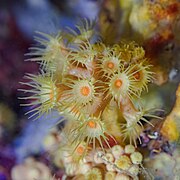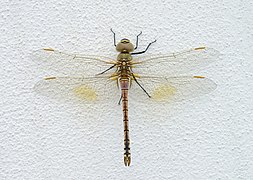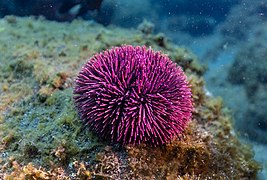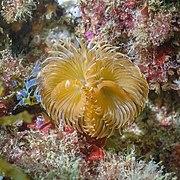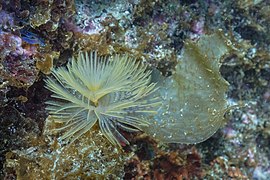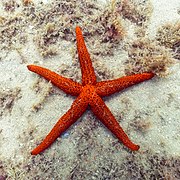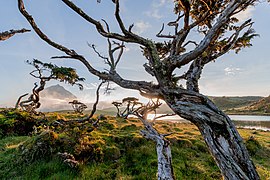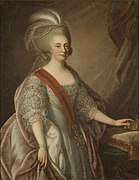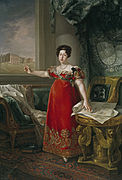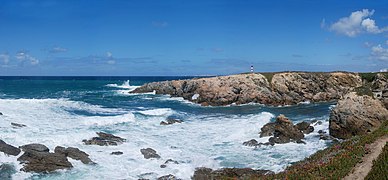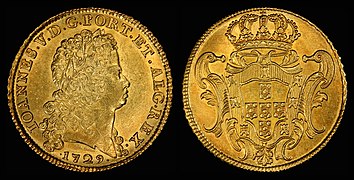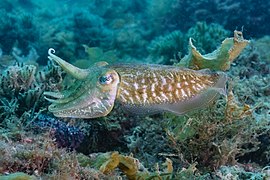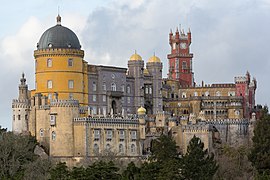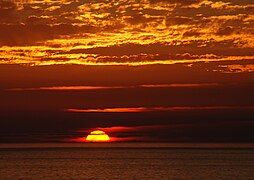
Back بوابة:البرتغال Arabic دەروازە:پورتوگال CKB Portál:Portugalsko Czech Portal:Portugal German Portal:Portekiz DIQ Portal:Portugal Spanish Atari:Portugal Basque Portail:Portugal French Portal:Portugal Galician Պորտալ:Պորտուգալիա Armenian
Welcome to the Portugal portal  Portugal, officially the Portuguese Republic, is a country in the Iberian Peninsula in Southwestern Europe. Featuring the westernmost point in continental Europe, Portugal borders Spain to its north and east, with which it shares the longest uninterrupted border in the European Union; to the south and the west is the North Atlantic Ocean; and to the west and southwest lie the Macaronesian archipelagos of the Azores and Madeira, which are two autonomous regions of Portugal. Lisbon is the capital and largest city, followed by Porto, which is the only other metropolitan area. The western part of the Iberian Peninsula has been continuously inhabited since prehistoric times, with the earliest signs of settlement dating to 5500 BC. Celtic and Iberian peoples arrived in the first millennium BC. The region came under Roman control in the second century BC, followed by a succession of Germanic peoples and the Alans from the fifth to eighth centuries AD. Muslims conquered the entirety of Portugal's current mainland in the eighth century, but they were gradually expelled by the Christian Reconquista over the next several centuries. Modern Portugal began taking shape during this period, initially as a county of the Christian Kingdom of León in 868, officially declared a sovereign Kingdom with the Treaty of Zamora in 1143. During the Age of Discovery, the Kingdom of Portugal settled Madeira and the Azores, and established itself as a major economic and political power, largely through its maritime empire, which extended mostly along the South Atlantic and Indian Ocean coasts. Portuguese explorers and merchants were instrumental in establishing trading posts and colonies that enabled control over spices and slave trades. While Portugal expanded its influence globally, its political and military power faced internal and external challenges towards the end of the 16th century. The dynastic crisis marked the beginning of the country's political decline that led to the Iberian Union (1580-1640), a period in which Portugal was united under Spanish rule. While maintaining a degree of self-governance, the union strained Portugal’s autonomy and drew it into conflicts with European powers which targeted Portuguese territories and trade routes. Portugal's prior opulence was further diminished by a series of events, such as the Portuguese Restoration War and the 1755 Lisbon earthquake, which destroyed the city and damaged the empire's economy. (Full article...) Selected article - Coimbra (/koʊˈɪmbrə/, also US: /kuˈ-, ˈkwɪmbrə/, UK: /ˈkɔɪmbrə/, Portuguese: [kuˈĩbɾɐ] ⓘ or [ˈkwĩbɾɐ]) is a city and a municipality in Portugal. The population of the municipality at the 2021 census was 140,796, in an area of 319.40 square kilometres (123.3 sq mi). The fourth-largest agglomerated urban area in Portugal after Lisbon, Porto, and Braga, it is the largest city of the district of Coimbra and the Centro Region. About 460,000 people live in the Região de Coimbra, comprising 19 municipalities and extending into an area of 4,336 square kilometres (1,674 sq mi). Among the many archaeological structures dating back to the Roman era, when Coimbra was the settlement of Aeminium, are its well-preserved aqueduct and cryptoporticus. Similarly, buildings from the period when Coimbra was the capital of Portugal (from 1131 to 1255) still remain. During the late Middle Ages, with its decline as the political centre of the Kingdom of Portugal, Coimbra began to evolve into a major cultural centre. This was in large part helped by the establishment of the first Portuguese university in 1290 in Lisbon and its relocation to Coimbra in 1308, making it the oldest academic institution in the Portuguese-speaking world. Apart from attracting many European and international students, the university is visited by many tourists for its monuments and history. Its historical buildings were classified as a World Heritage site by UNESCO in 2013: "Coimbra offers an outstanding example of an integrated university city with a specific urban typology as well as its own ceremonial and cultural traditions that have been kept alive through the ages." (Full article...) This is a Featured article, which represents some of the best content on English Wikipedia.
 The Palace of Queluz (Portuguese: Palácio de Queluz, Portuguese pronunciation: [kɛˈluʃ]) is an 18th-century palace located at Queluz, a city of the Sintra Municipality, in the Lisbon District, on the Portuguese Riviera. One of the last great Rococo buildings to be designed in Europe, the palace was conceived as a summer retreat for King Joseph I's brother, Peter of Braganza, later to become husband and king jure uxoris (as King Peter III) to his own niece, Queen Maria I. It eventually served as a discreet place of incarceration for Maria I, when she became afflicted by severe mental illness in the years following Peter III's death in 1786. Following the destruction of the Palace of Ajuda by fire in 1794, Queluz Palace became the official residence of the Portuguese Prince Regent John, and his family, and remained so until the royal family fled to the Portuguese colony of Brazil, following the French invasion of Portugal (1807). Work on the palace began in 1747 under Portuguese architect Mateus Vicente de Oliveira. Despite being far smaller, the palace is often referred to as the "Portuguese Versailles." From 1826, the palace slowly fell from favour with the Portuguese sovereigns. In 1908, it became the property of the state. Following a serious fire in 1934, which gutted one-third of the interior, the palace was extensively restored, and today is open to the public as a major tourist attraction. (Full article...) General imagesThe following are images from various Portugal-related articles on Wikipedia.
Selected quote -"To Angola! Quickly and strongly!"
Para Angola, rapidamente e em força! This is a Good article, an article that meets a core set of high editorial standards.
Póvoa de Varzim (European Portuguese pronunciation: [ˈpɔvu.ɐ ðɨ vɐɾˈzĩ] ⓘ) is a Portuguese city in Northern Portugal and sub-region of Greater Porto, 30 km (18.6 mi) from its city centre. It sits in a sandy coastal plain, a cuspate foreland, halfway between the Minho and Douro rivers. In 2001, there were 63,470 inhabitants, with 42,396 living in the city proper. The city expanded southwards, to Vila do Conde, and there are about 100,000 inhabitants in the urban area alone. It is the seventh-largest urban agglomeration in Portugal and the third largest in Northern Portugal. Permanent settlement in Póvoa de Varzim dates back to around four to six thousand years ago. Around 900 BC, unrest in the region led to the establishment of Cividade de Terroso, a fortified city, which developed maritime trade routes with the civilizations of classical antiquity. Modern Póvoa de Varzim emerged after the conquest by the Roman Republic of the city by 138 BC; fishing and fish processing units soon developed, which became the foundations of the local economy. By the 11th century, the fishing industry and fertile farmlands were the economic base of a feudal lordship and Varzim was fiercely disputed between the local overlords and the early Portuguese kings, which resulted in the establishment of the present day's municipality in 1308 and being subjugated to monastic power some years later. Póvoa de Varzim's importance reemerged with the Age of Discovery due to its shipbuilders and merchants proficiency and wealth, who traded around the globe in complex trade routes. By the 17th century, the fish processing industry rebounded and, sometime later, Póvoa became the dominant fishing port in northern Portugal. (Full article...) Selected Biography -Marcelo Nuno Duarte Rebelo de Sousa GColTE GCIH ComSE (European Portuguese: [mɐɾˈsɛlu ʁɨˈβelu ðɨ ˈsozɐ]; born 12 December 1948) is a Portuguese politician and academic. He is the 20th and current president of Portugal, since 9 March 2016. He is a member of the Social Democratic Party, though he suspended his party membership for the duration of his presidency. Rebelo de Sousa has previously served as a government minister, parliamentarian in the Assembly of the Portuguese Republic, legal scholar, journalist, political analyst, law professor, and pundit. (Full article...) Selected picture - Lisbon Oceanarium, a marine biology museum and one of the largest aquariums in the world.
Did you know -
Portugal topicsPortugal lists
SubcategoriesRecognized content
Featured articlesFormer featured articlesFeatured listsFormer featured listsGood articles
Former good articlesDid you know? articles
Featured pictures
Former featured portalsIn the News articles
Main page featured articles
Picture of the day pictures
Featured topicsNew articlesThis list was generated from these rules. Questions and feedback are always welcome! The search is being run daily with the most recent ~14 days of results. Note: Some articles may not be relevant to this project.
Rules | Match log | Results page (for watching) | Last updated: 2025-01-12 21:36 (UTC) Note: The list display can now be customized by each user. See List display personalization for details.
Things you can doRelated PortalsRelated WikiProjects
Associated WikimediaThe following Wikimedia Foundation sister projects provide more on this subject:
Discover Wikipedia using portals
|

















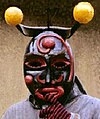





















![Image 39Maios celebration in Madeira island [1] (from Culture of Portugal)](http://upload.wikimedia.org/wikipedia/commons/thumb/e/e1/2011-03-05_03-13_Madeira_045_Santana_%285543431418%29.jpg/120px-2011-03-05_03-13_Madeira_045_Santana_%285543431418%29.jpg)












